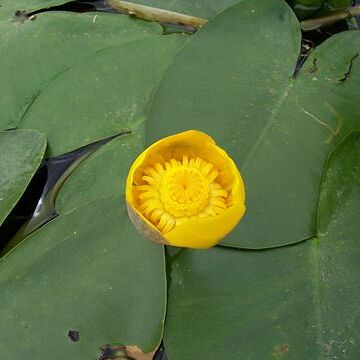Herbs perennial. Rhizomes repent, branched. Leaves dimorphic, either floating with thick leathery blades and long petioles or submersed with thin, papery blades and short petioles; leaf blade ovate to elliptic, venation primarily pinnate, base cordate, margin entire, not peltate. Flowers hypogynous, emergent, perianth ± upright. Sepals (4--)5(--7), yellow or orange, petaloid, oblong to obovate, persistent. Petals numerous, yellow, small, stamenlike. Stamens nearly as long as sepals, inserted at base of ovary; filament strap-like; anthers yellow, connective unappendaged. Carpels completely united. Style absent. Stigma sessile and radiate on flattened stigmatic disc, lacking marginal appendages. Fruit ovoid to urceolate, irregularly dehiscent. Seeds smooth, not arillate.
Sep mostly 6, sometimes only 5, concave, imbricate, petaloid, forming a subglobose or deeply saucer-shaped yellow fl; pet many, much smaller than the sep, usually shorter than the numerous, hypogynous stamens; stigmatic disk with 6–24 radiating lines; lf-blades basally cordate to hastate; petioles and peduncles with numerous minute air-cavities; 2n=34. (Nymphaea of auth., misapplied) 15, N. Temp. and cold.
Rhizomatous. Lvs floating or emergent, entire, deeply cordate, exstipulate, green to dark purple beneath, with forking, non-anastomosing lateral veins. Sepals usually 6, yellowish green outside, yellow within. Petals numerous, yellowish, < sepals. Ovary superior. Seeds without aril.

